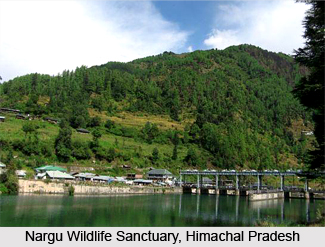 Nargu Wildlife Sanctuary is spread across the Uhl River which flows through Mandi District in the Indian state of Himachal Pradesh and is present along the banks of this river. The unique green corridors and vegetation cover of this wildlife sanctuary attract numerous tourists and wildlife lovers from all across the country. A large variation of flora and fauna can be observed in this wildlife reserve, and the sanctuary aims at enhancing awareness about the regional forests and wild animals. Nargu Wildlife Sanctuary is adjoining to the Khokhan Sanctuary. Visitors will discover that the portions of this place which are close to Uhl River are indeed picturesque and offer the most mesmerizing views. Barog Village lies in the close vicinity of this famous wildlife sanctuary. The total area occupied by Nargu Wildlife Sanctuary measures about 27, 837 hectares and it is existent at a height of about 970 metres to 4, 034 metres above mean sea level.
Nargu Wildlife Sanctuary is spread across the Uhl River which flows through Mandi District in the Indian state of Himachal Pradesh and is present along the banks of this river. The unique green corridors and vegetation cover of this wildlife sanctuary attract numerous tourists and wildlife lovers from all across the country. A large variation of flora and fauna can be observed in this wildlife reserve, and the sanctuary aims at enhancing awareness about the regional forests and wild animals. Nargu Wildlife Sanctuary is adjoining to the Khokhan Sanctuary. Visitors will discover that the portions of this place which are close to Uhl River are indeed picturesque and offer the most mesmerizing views. Barog Village lies in the close vicinity of this famous wildlife sanctuary. The total area occupied by Nargu Wildlife Sanctuary measures about 27, 837 hectares and it is existent at a height of about 970 metres to 4, 034 metres above mean sea level.
History of Nargu Wildlife Sanctuary
Nargu Wildlife Sanctuary was developed in the year 1962 and was later officially declared a sanctuary during 1974. This sanctuary is said to be amongst the most densely populated reserves in the state of Himachal Pradesh.
Flora of Nargu Wildlife Sanctuary
Various types of forests will be noticed by visitors to Nargu Wildlife Sanctuary which include Moist Deodar Forests, Sub-Tropical Pine Forests, Sub-Alpine Forests, Western Mixed Coniferous Forests and trees like Kharsu Oak, Moru Oak and Ban Oak. Besides, Himalayan plants and herbs also grow here. These rich forests enhance the natural beauty of the wildlife sanctuary to a great extent.
Fauna of Nargu Wildlife Sanctuary
A large quantity of birds and beasts dwell inside the vast grounds of Nargu Wildlife Sanctuary. The wild creatures which are on the prowl here consist of Himalayan Palm Civet, Rhesus Macaque, Barking Deer, Brown Bear, Common Langur, Himalayan Black Bear, Indian Porcupine, Leopard, Common Giant Flying Squirrel, Indian Hare, Marten, Himalayan Weasel and so on. Different species of Pheasants and Monals are also existent in this sanctuary.
Travellers can easily enjoy exciting opportunities of trekking and other adventure activities in this area, through some thrilling routes. One must approach the sanctuary during the summer season, particularly during the period between April and May.











